The recent State of the Connected Customer Report by Salesforce revealed that for 80 percent of people, the experience a brand provides is as important as its product. With customer expectations at an all-time high, businesses must deliver the best service possible to satisfy consumers and stay competitive. For that, it’s crucial to understand what customers want and anticipate their actions.
A customer journey map is vital in this context. It helps businesses understand and manage interactions with their clientele at every touchpoint, from the first encounter to the final transaction. So this post is all about the tool that guides you in creating exceptional customer experiences and how you can get the most out of it.
What is customer journey mapping?
Customer journey mapping is creating a visual story of customers' interactions with the brand or product. It's like drawing a route people usually take from the moment they first become aware of your product or service all the way through to purchasing and even after-sales support.
A customer journey map includes all the touchpoints the customer can have with your brand, such as seeing a social media ad, visiting a store, calling customer support, and so on. Also, it should reflect the customers’ pain points, emotions, and reactions at every stage of the journey so that you understand them better and see how to improve their experience.
Why is customer journey mapping important?
Before we delve into the details of customer journey mapping, let’s say a few words about why do it at all. Here are some of its benefits.
Understand your customers better. Customer journey mapping helps you see your business through your customers' eyes. You get to understand what they like, what bothers them, and what makes them happy.
Find problems. Sometimes, there are bumps in the road that can make your customers unhappy, like a confusing website or long wait times. Journey mapping helps you spot these problems so you can address them.
Adjust your strategy. As you get to understand your customers better, you might realize that you have to tailor your offerings, pricing range, marketing campaigns, support team workflows, etc.
Improve customer experience and foster loyalty. When you know what your customers go through, you can make their journey smoother and more enjoyable. This means increased conversion and retention rates. Happy buyers are likelier to keep returning and recommend your brand to others. Research states that 88 percent of customers repeat the purchase if they like the customer service.
In essence, customer journey mapping is a tool that helps businesses empathize with their customers and improve their interaction journey, leading to better customer-brand relationships and business success.
Customer journey stages
As we start exploring a customer journey map, let’s first look at what a common customer journey looks like. Here are its main phases.

Customer journey stages
Awareness. This is the initial stage where potential customers realize they have a need or a problem that requires solving and become aware of a product or service.
Potential touchpoints at this stage: social media, industry events, online/offline ads, search results, etc.
Consideration. At this stage, customers look for solutions. They are considering different products or services and are researching to find the best option.
Potential touchpoints at this stage: your website, blog, knowledge base, reviews, testimonials, case studies, etc.
Decision. This is the point where the customer decides on a solution that best fits their needs.
Potential touchpoints at this stage: email newsletter, pricing information, your website, physical store, sales reps, etc.
Purchase. The customer buys the product or service and starts using it.
Potential touchpoints at this stage: customer support (phone, messages, chatbots), help desk/FAQ sections, etc.
Retention. After the purchase, the focus shifts to keeping the customer happy and engaged with the product or service. This stage is about building loyalty and encouraging repeat purchases.
Potential touchpoints at this stage: email, newsletters, sales reps, etc.
Please note that this is the typical scenario but not the only one. The stages can vary across industries and product types, so you might want to include other phases in your customer journey map. Or else, you might need to map out only one part of the journey, for example, pre-purchase, to better understand how your marketing campaigns work.
What’s included in a customer journey map?
When creating a customer journey map, you’ll evaluate your buyer’s interactions with your brand and look for opportunities to enhance their experience. So here are the main elements of a customer journey map.
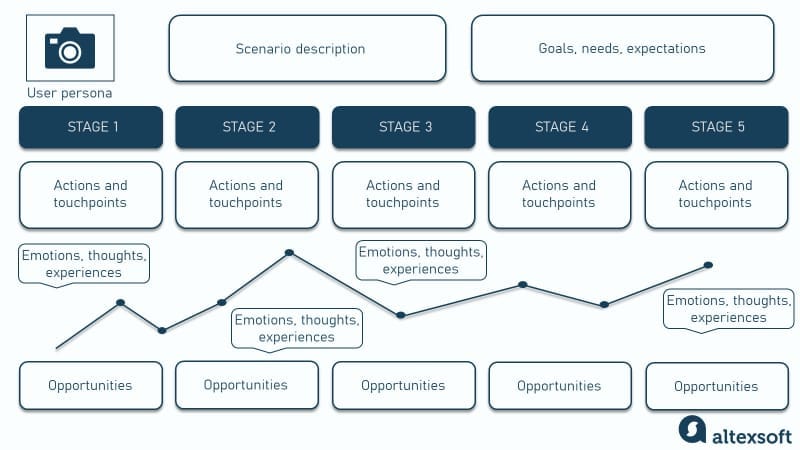
Elements of a customer journey map
Buyer/user/customer persona – a prototype of your target audience.
Scenario – a short description of the interaction story.
Customer’s goals/needs/expectations – why people turn to your brand.
Stages – the phases your customer goes through in the interaction scenario.
Actions and touchpoints – what customers do and where the interaction happens.
Emotions and experiences – what customers feel and think as they interact with your brand.
Emotional curve – the visual line of how the customer sentiment changes depending on their experience.
Opportunities – how you can improve the customer experience at each touchpoint or stage.
You can also include other elements like KPIs to track, designated people responsible for implementing improvements, and so on. The complexity and elements of a customer journey map can vary based on the nature of your business, the type of customers, and your goals.
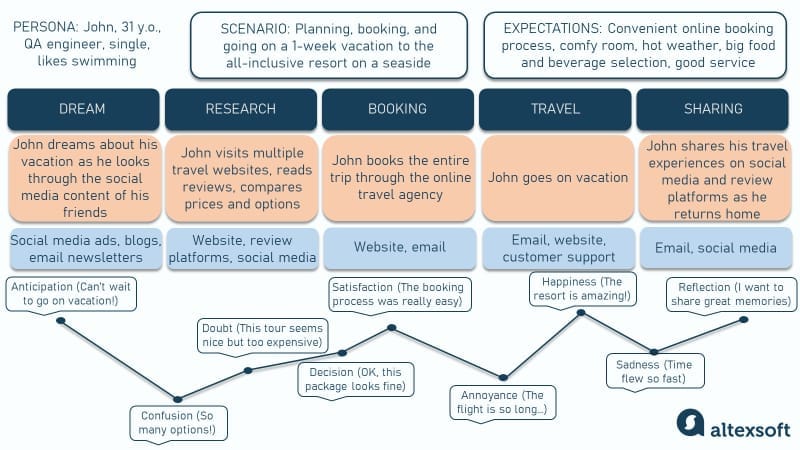
A simple example of a traveler journey map that an OTA or a hotel could create
The components of the customer journey map also depend on its type. There are many different modifications you can create for various business goals, so let’s talk about some of them.
Customer journey map types
Each customer journey map has its own focus and purpose. The choice of which one to use depends on your specific objectives, the complexity of your customer experience, and the information you want to capture. Here are some of the main types.
Current state journey maps provide a detailed view of the existing customer experience (just like in the illustration above). It’s the most basic map that documents touchpoints, interactions, and emotions “as is.”
Future state journey maps envision the ideal customer journey after implementing improvements or changes. They serve as a roadmap for designing and delivering a better customer experience and help teams set goals and prioritize initiatives to reach the desired state.
Day-in-the-life journey maps focus on a specific persona or customer segment's daily activities and how they interact with a product or service throughout their day. These maps help businesses understand a customer's routines and identify opportunities to provide value.
Channel-specific journey maps concentrate on a particular customer interaction channel, such as a website, mobile app, social media, or in-store experience. They help businesses optimize touchpoints within a specific channel.
Service blueprints go beyond the customer perspective and provide a comprehensive view of the entire service ecosystem. They include the customer journey, frontstage interactions (visible to the customer), and backstage processes (invisible to the customer). Service blueprints help improve alignment and coordination within an organization.
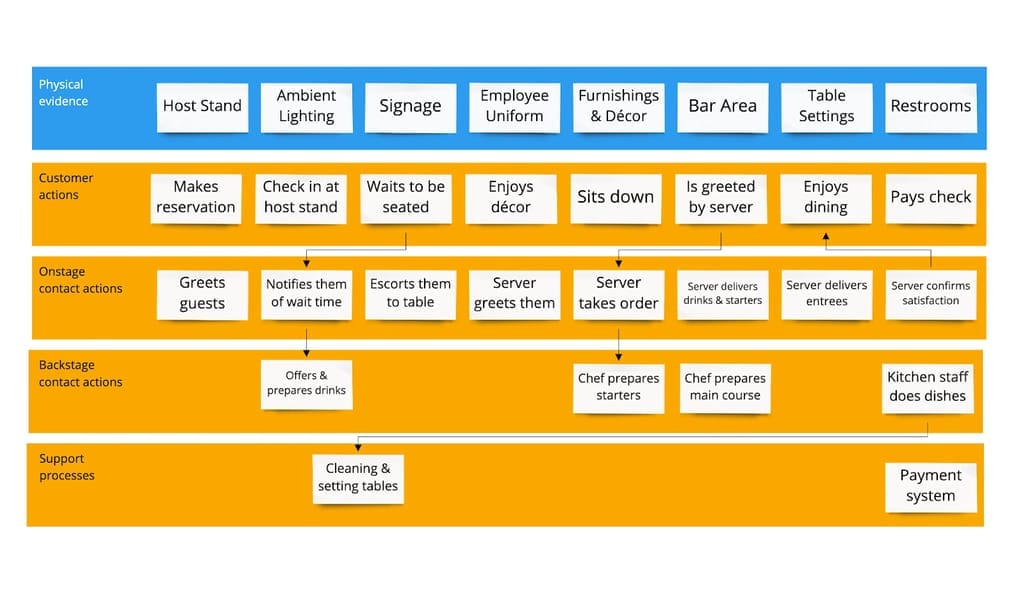
An example of a service blueprint for visiting a restaurant. Source: Miro
Some other types are emotional journey maps, lifecycle journey maps, cross-channel journey maps, etc. You can focus on a specific category or use a combination of these maps to better understand your customer journey and drive improvements in the customer experience.
How do you create and use a customer journey map?
There’s no single best format for a customer journey map. It can be a linear timeline, flowchart, or any other visual representation that best suits your needs. You can draw it on paper, put sticky notes on a whiteboard, or design it in specialized software (we’ll talk about digital tools further on).
Since customer journey mapping is part of market research, usually, it’s the marketing or sales department that’s responsible for creating it. However, it’s worth engaging different teams in this process.
Define objectives
First of all, you have to decide on your goals – or why you want to analyze your customer journey. For example, it can be something as specific as checking how a particular marketing project works, i.e., how effective ad retargeting is. Or it can be a strategic business objective like attracting more customers, increasing sales volume per customer, or improving retention.
Pro tip: Make a customer journey map for a specific interaction scenario for a certain customer segment. This way, it won’t be too generic, so you’ll be able to explore your buyers’ sentiments more deeply at each stage of their way and get more concrete results to work with.
Create a buyer persona
As we said, you must create a fictional representative of your target audience. To understand their needs and pain points, design a persona with a specific traits -- professional background, motivations, lifestyle, goals, and so on.
Pro tip: Add as many details as possible to make the most accurate representation of your customer. Later on, it will help you better understand their perspective.
Identify touchpoints and map the customer journey
As we said, you have to define the ways customers interact with your brand at each stage. Make a list of all the potential touchpoints and then map them out on the customer journey stages.
Use various data sources such as website analytics, customer feedback, social media interactions, and sales data to gather information about where and how customers interact with your brand. Also, engage teams from various departments (sales, customer support, marketing) and encourage their input.
Pro tip: Look at your competitors to see where they engage with customers. This can provide insights into touchpoints you haven’t considered.
Understand the customer's perspective
As you record your customers' actions at each stage, remember to make the map from the customer's point of view. It must show what they think and feel at each touchpoint, what they're trying to achieve, and any challenges they might face.


Watch our expert explain customer research in product discovery
Get feedback directly from your customers through surveys, interviews, or email questionnaires to understand their experience at different touchpoints. Ask about their motivations and any difficulties they encountered.
Pro tip: Tools like website heat maps, open rates for emails, and engagement rates on social media can help you understand your customers’ behavior better.
Highlight emotions and experiences
A customer journey map goes beyond the actions customers take. It dives into their emotional experience, whether they're happy, frustrated, or confused at different stages.
It’s important to record both positive and negative emotions. The former exhibits opportunities to enhance the experience or exceed customer expectations, while the latter highlights pain points or bottlenecks where customers face challenges or frustrations.
Pro tip: Ask your customer support which questions they get most often. Also, pay attention to what customers say about your brand on social media, online review platforms, or other resources.
Identify opportunities for improvement
By mapping this journey, you can see where you're providing a great experience and where you fall short. This helps you find ways to enhance your strong sides and improve the weak ones. For example, some reasons for poor customer experience include long waiting times to get to customer service, unintuitive website interface, missing app functionality, high prices, and so on.
Pro tip: Conduct brainstorming sessions with different teams and encourage active cross-department collaboration. Also, try to go through the journey that you’ve depicted yourself to get first-hand experience.
Create a better customer experience
Ultimately, the goal is to use this map to make strategic decisions that enhance the customer experience, leading to higher satisfaction and loyalty. Develop strategies and initiatives to address the pain points, optimize touchpoints, and leverage opportunities identified in the customer journey map.
Pro tip: Focus on your business goals when you analyze the impact of customer experience and prioritize your activities.
B2B customer journey map
If your company doesn’t work with individual customers but deals with other businesses, you can still take advantage of a customer journey map. A B2B customer journey map is a useful tool for managing client relationships. Just like the B2C analog, it visualizes the process they go through and experiences they have when interacting with your company. However, there are certain differences that impact the components of the customer journey map.
The complexity of the decision-making process. In the B2B context, there’s a more complex decision-making process, often with multiple stakeholders. The journey may include stages like RFP (Request for Proposal) submission, detailed product evaluations, approvals from different departments, and a longer negotiation phase. In B2C, the decision-making process is usually simpler and quicker, often involving only the individual consumer or their immediate family.
Length of sales cycle. B2B sales cycles are typically longer, sometimes lasting months or even years, as they involve higher-value transactions and more deliberation. B2C sales cycles are shorter, often concluding within a few days or even instantly.
Touchpoints. B2B touchpoints include industry events, professional networks, detailed product demos, and extensive follow-up communications. B2C touchpoints often focus more on mass marketing channels like social media, online ads, reviews, and retail environments.
Customer goals and expectations. Business customers often have specific, pragmatic goals like improving efficiency, increasing ROI, or integrating with existing systems. Meanwhile, individual consumer goals may be more diverse, including personal enjoyment, convenience, price, and brand alignment.
Relationship and engagement. B2B focuses more on building long-term relationships and ongoing engagement. In the B2C model, while repeat business is also important, engagement is often more transactional and less personalized unless it’s a high-value product or a niche market.
Just like in a B2C context, delivering a positive experience to your business clients is important. Customer journey mapping helps you understand how you can enhance your relationships.
Customer journey mapping software
As we said, you can certainly map your customer journey on a sheet of paper, but we recommend you use a specialized digital tool instead. The software helps automate this process, allows for convenient collaboration, and enables easy editing, sharing, and so on. Besides, most platforms offer several editable templates for different purposes.
There are multiple tools available to help you with customer journey mapping. A simple online search will give you a list of relevant platforms. Some are designed specifically to manage customer experience, while others are more general-purpose and can be used for different scenarios.
When choosing a tool, we recommend you consider the following factors:
- pricing,
- available templates,
- integration options,
- interface intuitiveness,
- customization options,
- collaboration features, and
- customer support and training.
We’ll take a look at some of them to give you an idea of what’s out there. Please note that we don’t promote any of the tools; the choice was based on their popularity.
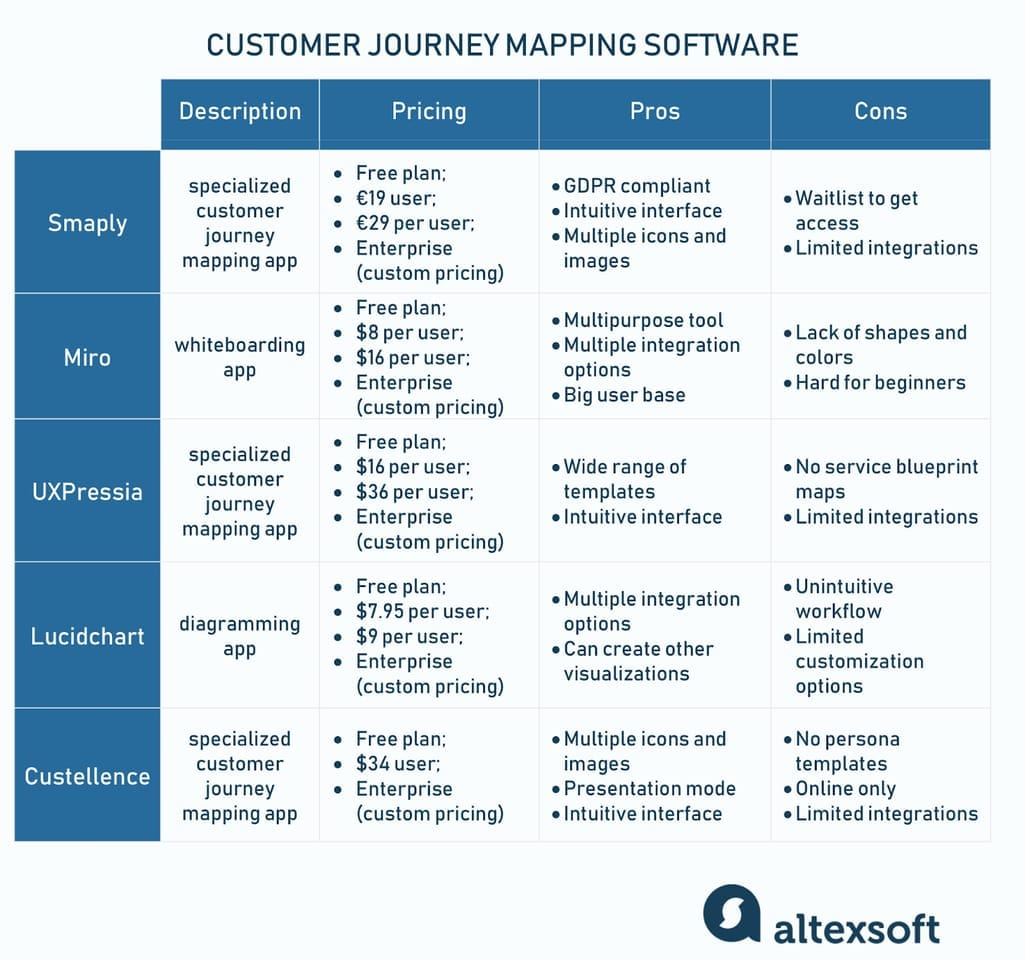
Customer journey mapping tools compared
Smaply is a specialized, user-friendly tool for journey mapping. It allows businesses to create detailed customer personas, journey maps, and other related visuals. It’s particularly good for visualizing complex customer interactions over multiple channels.
Miro is a multipurpose online collaborative whiteboarding platform. It offers numerous templates and tools for creating detailed customer journey maps, making it easier to visualize the customer experience.
UXPressia is specifically designed for creating customer journey maps with 100+ templates and customization options. It offers a persona creation feature, impact mapping, and the ability to integrate real data into your maps. You can also connect it to Jira, Google Analytics, and other external apps to add information to your maps.
Lucidchart is a diagramming app that helps create flowcharts, organizational charts, customer journey maps, etc. Besides creating visuals, it offers integration options with popular business tools like Google Workspace, Atlassian, and Slack.
Custellence is another focused customer journey mapping app. It has numerous templates for different industries and an intuitive, drag-and-drop user interface.
Customer journey map templates
As we’ve already mentioned, most software tools provide interactive templates for different scenarios. But if you don’t want to work on any focused platform, here are some downloadable templates for you:
We realize it might be confusing at the beginning when you don’t have a clear idea of how to approach customer journey mapping. For inspiration, check out some examples of how it might look.
Customer journey map examples
Companies create customer journey maps for a wide range of scenarios and with different purposes. While the objective isn’t always about getting more profit, it’s always about enhancing customer experience.
Multiple use cases. UXPressia has a big section with customer journey map examples for many industries, including banking, travel, entertainment, and so on. Within each industry subsection, they cover multiple scenarios, plus they provide different user persona examples.
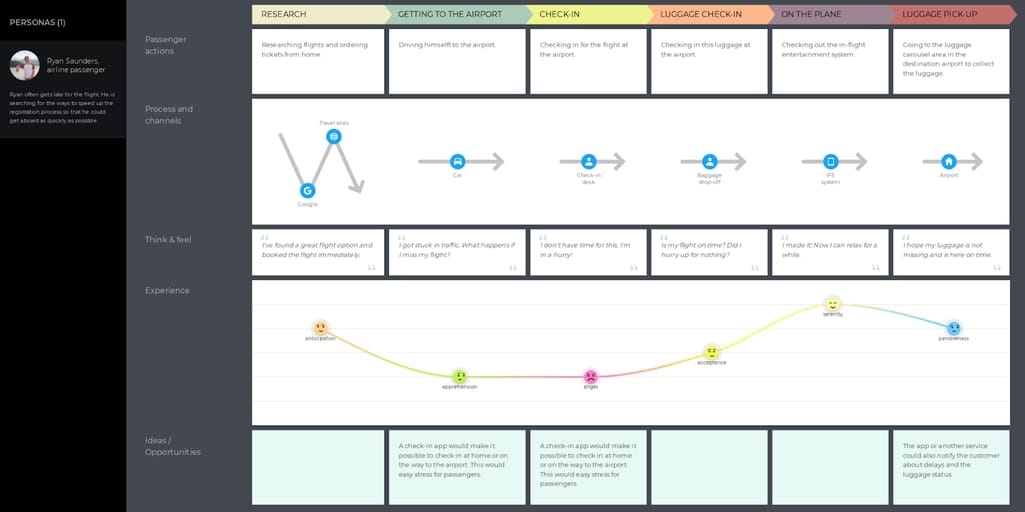
A customer journey map for an airplane passenger. Source: UXPressia
Attending city tours. Mural, a visual planning and collaboration tool, has created a customer journey map for travelers on guided city tours. The steps include browsing, booking, attending, and rating the tours.
Sharing music on Spotify. Meghana Bowen, a UX/UI designer, presented a customer journey map of using the Spotify app and sharing music with others. The author has also defined a user persona and depicted the following process of creating the sharing feature design.
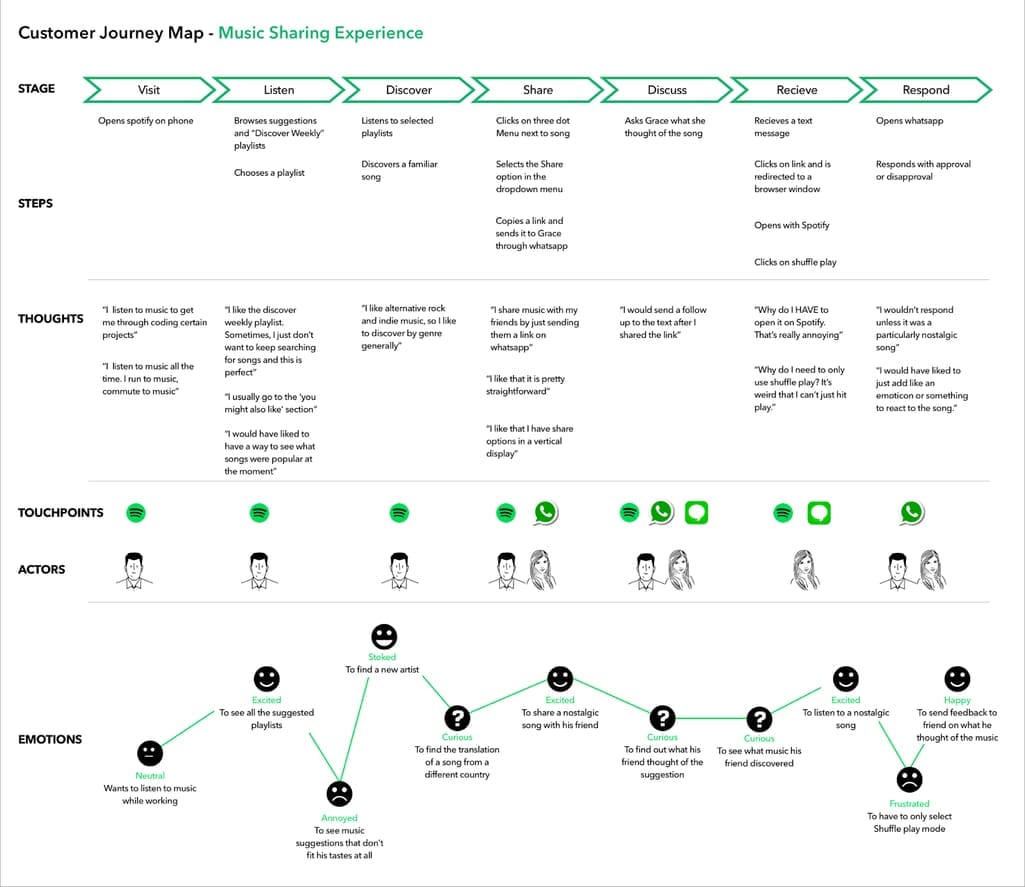
Spotify customer journey map. Source: Meghana Bowen
New students coming to the university campus. Iris Wu and Mei Xue created a service to facilitate traveling to Carnegie Mellon for incoming students. As part of their research, they’ve designed current and future customer journey maps to better understand the difficulties that international students encounter.
Best practices
We’ve already included some pieces of practical advice in the previous sections, but we still have a few more final tips.
Collaborate. We’ve mentioned it above but still want to emphasize the importance of cross-department collaboration when creating and working with the customer journey map. And, of course, involve your customers as well. Only in this case you’ll be able to have the most detailed information about your customer experience and improve it throughout all touchpoints.
Designate. As you implement changes, it’s crucial to assign responsibilities so that everyone knows their roles and tasks in these projects.
Track. It’s also important to develop KPIs so that you can track progress. The metrics you choose will depend on your objectives, but some examples are customer satisfaction score, net promoter score, conversion rate, or churn rate.
Update. Remember that the customer journey is dynamic and can change over time. Regularly revisit and update your customer journey map to reflect any changes in customer behavior or market conditions.

Maria is a curious researcher, passionate about discovering how technologies change the world. She started her career in logistics but has dedicated the last five years to exploring travel tech, large travel businesses, and product management best practices.
Want to write an article for our blog? Read our requirements and guidelines to become a contributor.

